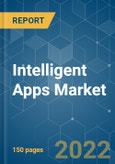The intelligent apps market is expected to register a growth at a CAGR of 32% over the forecast period (2021 - 2026). Advanced technology such as Machine Learning (ML) and Artificial Intelligence (AI) is continuously transforming businesses in every industry. From movie recommendations on Netflix, or suggested products on Amazon, to personalized ads from Google, intelligent apps have become part of everyone's daily life.
Key Highlights
- The increasing smartphone penetration across the world has been one of the major factors driving the market growth for intelligent apps globally. According to the 2020 published report by GSMA, there are over 3.5 billion smartphone users worldwide by the end of January 2020. The figure has shown an increase of over 30 million from that in the previous year.
- In the manufacturing sector, the importance of intelligent apps is rapidly increasing which are based on a SaaS analytical cloud application that acquires, stores, and makes the decision for operational data from shop floor systems including, equipment, machines, sensors, test stations, simulation machines combined with data from ERP and HCMs. AI and ML are the key technologies that are highly being used for understanding patterns and correlations to maximize productivity by mitigating quick decisions in case of downtime.
- Amid the ongoing outbreak of COVID-19, most of the countries worldwide have mandated the work from home. Being the software industry, it is hit at a lower level. Companies have been able to deliver the required intelligent applications. Moreover, this pandemic has also created opportunities for the market. The Indian government has introduced the Arogya Setu app to track and spread awareness about the COVID-19 in the country. To date, the app has generated over 9.8 crores downloads within the country.
Key Market Trends
Media and Entertainment Industry to Grow Significantly
- The broadcast and media companies are actively seeking to extend their content reach to the right where it is needed. Also, with the increasing number of people subscribing to OTT platforms, manual tagging of content is close to impossible with the time, as they need to process the massive volume of data. Hence, companies are making efforts to deploy or develop intelligent applications for users with value-added experiences.
- Netflix has the largest internet traffic source with almost 15% of downstream traffic. In 2019, Netflix was edged out by HTTP Media Stream, which is an HTTP-based adaptive bitrate streaming communications protocol developed by Apple Inc. The streaming channel has the most subscribers among the top five OTT providers with 138 million till 2019.
- According to the Global Internet Phenomena Report published by Sandvine, HTTP Media Stream, Netflix, and YouTube are in the top 5 for downstream bandwidth in each region (Americas, EMEA, APAC) and they drive overall video consumption.
North America Region to Witness Significant Growth
- North America region is one of the dominating regions for software development and innovation. Companies including Microsoft, Google, IBM, and Oracle are some of the major companies offering intelligent apps based in the region. Microsoft Corporation's Cortana is one of the best intelligent apps being used in daily lives. The app is a personal assistant app offering functionalities such as keeping track of important files and documents, setting reminders, etc.
- California-based GrayMeta is infusing its development platform with intelligent technology that analyses a customer's file systems on-premise and cloud with the help of computer vision and other AI services. The platform reduces the time consumption for manual review and tag content, resulting in increased process speed. With this development, the company has mentioned of reducing operational cost, as the cost is associated with the volume of computation used.
- Moreover, the smartphone manufacturers in the region are focusing on producing hardware components in accordance with the current trend for intelligent apps. For instance, the recently launched Apple iPhone SE is equipped with A13 Bionic chip for 5 trillion operations per second capacity, two ML accelerators on the CPU to balance performance and efficiency. The combination of A13 Bionic and iOS 13 has enhanced the intelligent app's capability in smartphones.
Competitive Landscape
The intelligent apps market is inclined towards fragmentation due to the presence of many established players in the market. Additionally, the market is experiencing continuous entry of new entrants due to less or no requirement of the initial investment. Hence, companies have been adopting a product innovation strategy. Some of the recent developments by the companies are mentioned below.
- May 2020 - Microsoft Corporation announced that its intelligent app Cortana will be integrated with voice assistant to the Teams iOS app. Instead of removing the voice assistant entirely from its library, The company is integrating Cortana into its other apps, including Teams. Cortana reportedly will respond to a user’s voice request to make a call or join a meeting from an iPhone.
- December 2019 - GE Healthcare launched more than 30 new intelligent applications and smart devices dedicated to drive efficiency in the radiology department. With this, the company is aimed to double the productivity and cost savings for systems by the year 2025. Additionally, clinicians will be benefited from the new technologies through intuitive workflows, improved diagnostic confidence, and less rework by allowing them to spend more time with patients.
Additional Benefits:
- The market estimate (ME) sheet in Excel format
- 3 months of analyst support
This product will be delivered within 2 business days.
Table of Contents
Companies Mentioned (Partial List)
A selection of companies mentioned in this report includes, but is not limited to:
- IBM Corporation
- Oracle Corporation
- Google LLC
- Apple Inc.
- Microsift Corporatio
- Baidu Inc.
- Amazon Web Services
- SAP SE
- Salesforce.com
- Intel Corporation
- HP Enterprises
- Clarifi Inc.
Methodology

LOADING...








